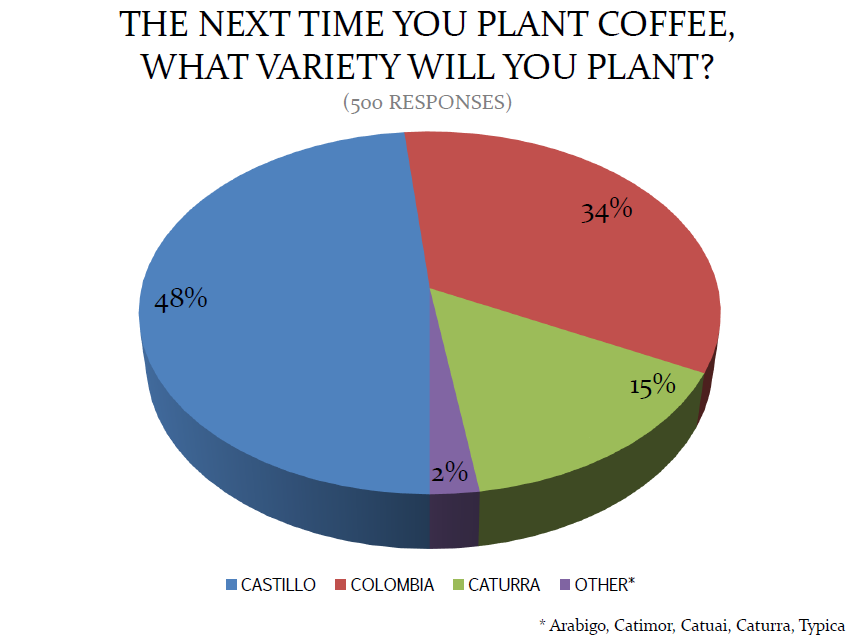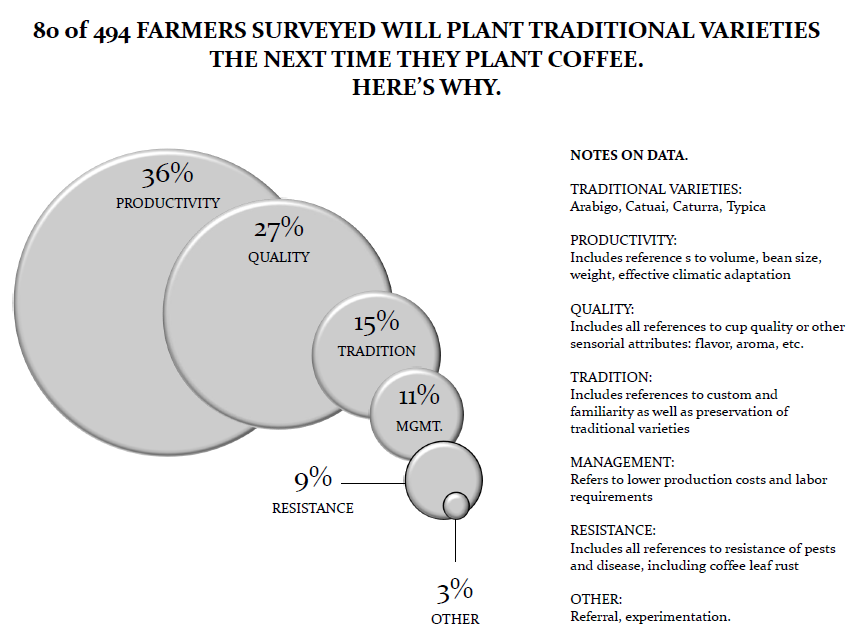The Castillo cultivar has been the subject of considerable discussion and no small amount of controversy in the marketplace in recent years. At the risk of oversimplification, the debate has been framed by two positions: that of representatives of Colombia’s Federación Nacional de Cafeteros, who insist that Castillo will thrive in the specialty market because its cup quality equal to that of the country’s traditional varieties, and that of quality-obsessed specialty roasters who insist it won’t because it isn’t. What we rarely hear in the debate are the voices of farmers who depend on coffee for their livelihoods and face the decision about what variety of coffee to plant on their farms in the context of a coffee leaf rust epidemic. So we asked some smallholder coffee farmers in Nariño to tell us what they think.
As part of the baseline survey for our Borderlands coffee project, we asked some 500 smallholder coffee farmers in Colombia the following three questions:
- The last time you planted coffee, what variety did you use?
- The next time you plant coffee, what variety will you use?
- Why?
The results suggest that there are very different narratives circulating in Colombia’s coffeelands around the country’s disease-resistant varieties (Castillo and Colombia), and its traditional varieties (mostly Caturra but also Arabigo, Catuai and Typica). It also suggests that while Castillo has made significant inroads, farmers haven’t given up altogether on traditional varieties. At least in Nariño.
A few things jump out at me from these two graphs:
- They suggest that Castillo has already made significant inroads in Nariño since it was released in 2005 — by 2012, more than half of all responses included reference to Castillo.
- Castillo is the most popular cultivar, but its use may actually be declining modestly, down from 51% to 48% of responses.
- The Colombia cultivar — one of Castillo’s predecessors — seems to be the variety with the most momentum in Nariño, increasing its share of survey responses from 23% to 34%.
But the big takeaways in my mind are these:
- The use of cultivars bred to resist disease using Robusta genetics — Castillo and Colombia — is up (from to 82% from 74% of responses).
- The use of Caturra, the most popular traditional cultivar in Nariño, is down (from 24% to 15% in the survey).
Even more interesting to me than what farmers will plant next time their renovate their farms, however, is why.
Here is what we heard from farmers who will plant Castillo, by far the single most popular cultivar among farmers surveyed.
Those who plan to plant with traditional varieties — Arabigo, Catuai, Caturra and Typica — explained their thinking this way.
Here again, the pictures tell a story or two.
The story of Castillo, as told by farmers, is one of resistance to coffee leaf rust and other diseases and strong productivity. Its principal appeal to farmers is that it will help them continue to achieve high levels of productivity at a time when production losses have been considerable.
Farmers see the value proposition of traditional varieties — principally Caturra — differently. While productivity is still the principal draw, there is a clear association with cup quality — it was the second-most frequent justification for planting traditional varieties. Only 2 percent of the reasons given for planting Castillo, by contrast, referenced cup quality.
And unlike the Castillo variety, which has little history behind it, these traditional high-quality cultivars elicit feelings of familiarity and even pride among farmers who see them as part of Colombia’s great coffee heritage.
– – – – –
This post is the fourth in a seven-part series titled “Colombia’s other eradication campaign.”
<< Previous: The origins of the Castillo cultivar.
Next: Credit for coffee in Colombia. >>






